Occupational environment monitoring of a two-wheeler vehicle manufacturing factory
99,000 ₫
Note: The above price is calculated for one sample, and the price may fluctuate depending on the area of the environment to be monitored and market movements. For more accurate pricing support, please refer to the price list or contact our consulting staff directly.
Monitoring the environment of a two-wheeler vehicle manufacturing factory is a session of collecting, analyzing, and evaluating factors at the workplace that may harm workers health.
Table of Contents
Toggle1. Overview of Two-Wheel Vehicle Manufacturing Factories
a. What is a Two-Wheel Vehicle Manufacturing Factory?
A factory that manufactures two-wheel vehicles is a production facility specializing in the manufacturing and assembly of motorcycles, which are two-wheeled means of transportation. This factory typically includes production lines, machinery, and specialized equipment to carry out the vehicle production and assembly processes.
The production process in a two-wheel vehicle factory includes machining parts, assembling the frame, installing the engine system, the electrical system, and conducting quality control steps.

b. Production Stages in a Two-Wheel Vehicle Manufacturing Factory
The production stages in a two-wheel vehicle factory may include:
- Parts machining: Before assembly, parts such as frames, wheels, suspension systems, brake systems, and other components are machined from materials such as steel, aluminum, rubber, plastic, etc.
- Painting and plating: Metal parts of the vehicle are painted and plated to enhance durability, prevent rust, and create an aesthetic surface.
- Frame assembly: The vehicle frame is the foundation for building the vehicle, so the frame assembly process is carried out carefully and precisely. Other parts such as exhaust pipes, steering systems, and suspension systems are also attached to the frame.
- Engine system installation: The engine is installed and connected to the frame. This includes setting up and connecting components such as the engine, gearbox, fuel system, cooling system, etc.
- Electrical system installation: The vehicle’s electrical system, including lighting, control systems, meters, and indicators, is installed and connected to ensure proper vehicle operation.
- Quality control: After the vehicle is completed, quality control is conducted to ensure that the vehicle meets quality and safety standards. This includes electrical testing, brake system testing, performance testing, and other inspections to ensure the vehicle operates safely and efficiently.
These stages may vary depending on the specific type of two-wheel vehicle and the factory’s production process.

c. Machinery Used in a Two-Wheel Vehicle Manufacturing Factory
In a two-wheel vehicle manufacturing factory, various types of machinery are used to carry out production stages. Some common machinery in the two-wheel vehicle industry includes:
- Steel cutting and bending machines: Used to cut and bend metal components such as exhaust pipes, frames, and suspension parts.
- Welding machines: Used to weld metal components together, including spot welding, Mig/Mag welding, Tig welding, etc.
- Lathes: Used to machine metal parts to produce precise components with the required shapes.
- Milling machines: Used to create grooves, flat surfaces, or complex shapes on metal components.
- Grinding machines: Used to smooth and shape metal surfaces, including surface grinding, cylindrical grinding, flat grinding, etc.
- Press machines: Used to press and shape plastic or rubber components during the production of parts such as seats and dashboards.
- Painting machines: Automatic or semi-automatic machines used to spray paint on metal parts to create a durable and aesthetically pleasing surface.
- Inspection machines: Quality inspection machines are used to check components such as engines, brake systems, electrical systems, and steering systems to ensure proper vehicle performance and compliance with quality standards.
Additionally, other machinery such as cutting, plastic molding, shaping machines, 3D printers, etc., may be used depending on the factory’s production technology and process.

d. Occupational Diseases for Workers in Two-Wheel Vehicle Manufacturing Factories
Workers in two-wheel vehicle factories may suffer from some occupational diseases, including:
- Respiratory diseases: Due to emissions, dust, and welding fumes from the production process, workers are at risk of pneumonia, asthma, sinusitis, or other respiratory issues.
- Hearing problems: Noise from machinery, tools, or production processes can damage hearing, causing deafness, reduced hearing, or tinnitus.
- Musculoskeletal disorders: Working in an industrial environment can put physical stress on muscles and joints, causing back pain, joint degeneration, arthritis, and related issues.
- Skin diseases: Exposure to wood materials, chemicals, oils, or other allergens can cause dermatitis, skin irritation, eczema, or other skin conditions.
- Mechanical injuries: Workplace accidents such as falls, collisions, or injuries from tools, machinery, or materials can cause trauma, fractures, bruises, cuts, etc.
- Thermal effects: Exposure to high temperatures, welding lights, or heating equipment can cause burns, thermal dermatitis, or other heat-related health problems.
To ensure safety and protect workers’ health, occupational safety measures must be applied, including wearing appropriate personal protective equipment, following safety procedures, controlling noise, ensuring ventilation, and providing health and safety training.

2. Overview of Occupational Environmental Monitoring Services
a. What is Occupational Environmental Monitoring for Two-Wheel Vehicle Factories?
Occupational environmental monitoring (or workplace environmental measurement) for two-wheel vehicle factories is the activity of collecting, evaluating, and analyzing indicators of occupational environment factors at the factory, aiming to implement timely measures to minimize environmental hazards to workers’ health and prevent occupational diseases. Occupational environmental monitoring is mandatory for two-wheel vehicle manufacturing factories.
Occupational environmental monitoring plays a critical role in safeguarding and enhancing worker health, as workers are the primary resource of the enterprise and directly generate profit. Prolonged exposure to hazardous factors above allowable limits can adversely affect health and cause occupational diseases.
REGISTER FOR OCCUPATIONAL ENVIRONMENTAL MONITORING SERVICE
b. Nam Viet’s Occupational Environmental Monitoring Program
Nam Viet’s occupational environmental monitoring program is designed by monitoring engineers in the field of occupational safety and environmental protection. To ensure worker health and safety, the program uses modern measurement methods to monitor air quality, water quality, microclimate, physical factors, dust, and more in the workplace. This program is crucial in maintaining a safe working environment and protecting worker health.
Additionally, Nam Viet’s monitoring program plays an important role in researching and developing new solutions to improve workplace environmental quality. With the dedication and professionalism of its expert monitoring team, Nam Viet’s exclusive program represents a breakthrough in occupational safety and environmental protection management in Vietnam.

c. Standardization in Workplace Environmental Measurement Procedures
Standardization in Nam Viet’s workplace environmental measurement procedures is essential for ensuring measurement accuracy and reliability. The program adheres to standards and standardized procedures recognized by the Ho Chi Minh City Department of Health. This ensures that collected data is highly reliable for assessing workplace conditions and making decisions to improve worker health and safety.
These standardized procedures also ensure that measurements are conducted by a highly qualified monitoring specialist team with extensive experience, allowing managers and experts to trust Nam Viet’s results and make accurate decisions valuable for protecting workers’ health and the environment.
By applying standardization in workplace environmental measurements, Nam Viet demonstrates its commitment to a safe working environment and protecting worker health, while contributing to the improvement of occupational safety and environmental management in Vietnam.
d. Reporting Occupational Environmental Monitoring Results for Two-Wheel Vehicle Factories
Occupational environmental monitoring results are prepared according to Form No. 04, Appendix III, issued with Decree 44/2016/NĐ-CP and produced in two copies: one copy is sent to the workplace that signed the monitoring contract, and the other copy is kept by the monitoring organization.
The retention period for monitoring results is indefinite, as regulated by law.

e. Frequency of Occupational Environmental Monitoring According to the Law
According to Clause 2 of Article 18 of the Law on Occupational Safety and Hygiene 84/2015/QH13, employers must organize occupational environmental monitoring to evaluate hazardous factors at least once a year.
f. Deadline for Submitting Occupational Environmental Monitoring Reports According to the Law
The deadline for submitting reports is before December 31 each year. Enterprises at production facilities are required to submit monitoring reports to the Department of Health in the locality where the production facility is headquartered and where workers are employed.
When there are changes in technology, production processes, or during renovation and upgrading that may introduce new hazardous factors affecting workers’ health, enterprises must update occupational hygiene records to include these factors and conduct environmental monitoring.
g. Penalties for Violations of Occupational Environmental Monitoring Regulations for Employers
According to Article 27 of Decree No. 12/2022/NĐ-CP dated January 17, 2022, on administrative penalties in labor, social insurance, and Vietnamese workers working abroad under contracts:
- Clause 2: Fines ranging from VND 2,000,000 to 5,000,000 for employers who fail to publicly disclose monitoring results to employees at the monitoring site and at the location where hazardous factors are assessed, immediately after receiving monitoring and assessment results.
- Clause 3: Fines ranging from VND 20,000,000 to 40,000,000 for employers who do not conduct occupational environmental monitoring to control hazards to workers’ health as required by law.
- Clause 4: Fines ranging from VND 40,000,000 to 60,000,000 for employers who collude with monitoring organizations to commit fraud in environmental monitoring activities, but not to the extent of criminal liability.
3. Harmful Environmental Factors for Workers in Two-Wheel Vehicle Manufacturing Factories
In two-wheel vehicle manufacturing factories, there are several environmental factors that may be harmful to workers. Some of these factors include:
- Noise: Machinery and production processes in the factory can generate high noise levels, affecting hearing and causing stress for workers.
- Dust and plastic particles: Processing, grinding, cutting, and painting of vehicles can create airborne dust and plastic particles. Inhaling dust and plastic particles can cause respiratory problems and irritation of the respiratory tract.
- Chemicals: Two-wheel vehicle factories may use chemicals such as solvents, cleaning agents, and adhesives. Long-term exposure to these chemicals can cause damage to the skin, eyes, or respiratory system.
- Temperature and humidity: Production areas in the factory may have high or low temperature and humidity conditions depending on the production process. Unfavorable environmental conditions can cause fatigue and discomfort for workers.
- Lighting: Insufficient lighting or strong artificial lighting in the factory can cause eye strain and affect workers’ vision.
- Occupational safety: Two-wheel vehicle factories may have safety hazards such as collisions, falling heavy objects, impacts, etc. The risk of workplace accidents and injuries can occur if safety rules are not followed.

REGISTER FOR WORKPLACE ENVIRONMENT MONITORING SERVICE
4. Measures to Improve Working Conditions in Two-Wheel Vehicle Manufacturing Factories
To improve working conditions in two-wheel vehicle manufacturing factories and protect workers’ health, the following measures can be applied:
- Noise management: Use soundproofing and thermal insulation measures and install noise barriers to reduce noise in the work area. Provide ear protection to workers to minimize the impact of noise on hearing.
- Control dust and chemicals: Use efficient dust extraction systems, install air filters, and ensure safe working procedures to reduce dust and chemicals in the air. Provide personal protective equipment such as masks, goggles, and gloves to prevent direct contact with dust and chemicals.
- Ensure proper ventilation: Provide an effective ventilation system to maintain fresh and clean air in the work area. This may include fans, air purifiers, and periodic ventilation system checks.
- Ensure proper lighting: Provide sufficient natural and artificial lighting evenly distributed throughout the work area. This helps reduce eye strain and increase work efficiency.
- Ensure occupational safety: Comply with safety rules and provide full personal protective equipment, such as helmets, goggles, gloves, safety shoes, and protective clothing. Train workers on occupational safety and risk management.
- Periodically conduct workplace environment monitoring in the factory, collect and analyze harmful factors affecting workers, and implement adjustments to reduce hazards and prevent occupational diseases.
5. Benefits of Periodic Monitoring in Two-Wheel Vehicle Factories
An Toan Nam Viet provides businesses with excellent benefits when using workplace environment monitoring services in accordance with Decree 44/2016/ND-CP on managing and controlling harmful factors in working environments affecting employees.
- Businesses can proactively control harmful factors in their factories or workshops.
- Receive recommendations on measures to reduce harmful factors and improve the quality of the working environment.
- Indirectly protect human resources, the key factor in enterprise development.
- Reduce the impact of occupational diseases on health, thereby minimizing future treatment costs.
- Improved employee health leads to better product quality and consistent production output.
- Comply with labor safety regulations and avoid legal risks.
- Enhance credibility and professionalism, elevating the business’s brand.
Nam Viet’s environmental monitoring service is a solution to minimize occupational disease risks, contributing to a clean and high-quality working environment.

6. Nationwide Workplace Environment Monitoring Center
Nam Viet Workplace Environment Monitoring Center is a professional unit specializing in monitoring and measuring workplace environmental quality throughout all provinces of Vietnam. With an experienced team of monitoring specialists, the center uses modern measuring equipment to ensure accuracy and reliability.
In addition to monitoring services, the center assists clients in planning, handling, and tracking workplace environmental issues. Following the motto “customer-centric,” the center prioritizes client satisfaction, meets all client needs, and provides the best solutions for businesses.
REGISTER FOR WORKPLACE ENVIRONMENT MONITORING SERVICE
With investment in technology, equipment, and personnel, Nam Viet’s monitoring center has become a reputable unit in workplace environment monitoring in Ho Chi Minh City, with objectives including:
- We always prioritize brand reputation and service quality.
- We provide clients with the best and most suitable solutions.
- Alongside a team of experienced Masters and Engineers committed to environmental protection and business benefits.
- By working with Nam Viet Environmental Monitoring, companies receive professional service from experts and the best cost advantages.
The workplace environment monitoring process at Nam Viet includes:
- Before monitoring, all machinery and equipment are calibrated according to legal regulations.
- Implement the complete monitoring process as committed to the Department of Health.
- Report monitoring results honestly to employers.
- If results indicate unsafe conditions, Nam Viet will provide solutions, and the enterprise will implement:
- Measures to improve working conditions, minimize harmful factor impacts, and prevent occupational diseases.
- Health check-ups to detect occupational and work-related diseases early for employees in unsafe environments.
- Provide in-kind benefits to employees according to labor laws.

7. Workplace Environment Monitoring Service Price List
To help businesses perform workplace environment monitoring professionally and effectively, Nam Viet provides clients with a quality and reasonably priced service price list.
- Our price list provides detailed information on the costs of monitoring services we offer, including transportation, measurement, analysis, and reporting. Clients can trust the accuracy and reliability of our monitoring reports.
- We commit to offering the most competitive and reasonable prices in the market and are always ready to answer questions about monitoring services quickly and professionally.
- With Nam Viet’s price list, clients can easily choose service packages that meet their needs. We are committed to delivering the highest satisfaction with professional service quality.
No comments yet


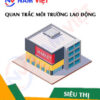
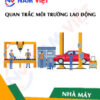


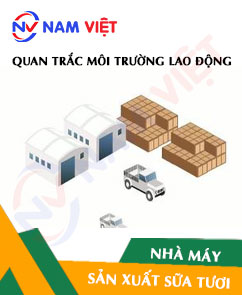
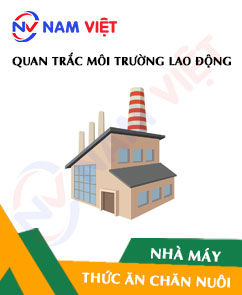

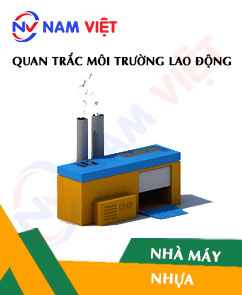

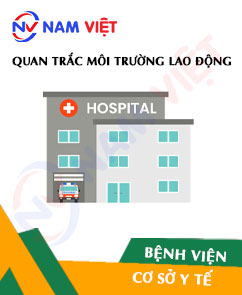
Review Occupational environment monitoring of a two-wheeler vehicle manufacturing factory
There are no reviews yet.